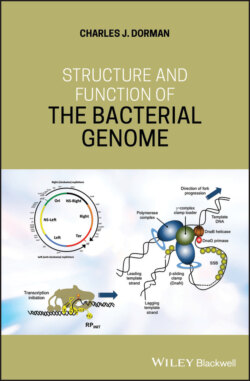Читать книгу Structure and Function of the Bacterial Genome - Charles J. Dorman - Страница 22
1.11 Some Bacterial Chromosomes Are Linear
ОглавлениеMost of the literature on bacterial chromosomes describes work with covalently closed, circular molecules. On the face of it, chromosome circularity is not essential for survival: work with E. coli has shown that linearisation of its circular chromosome through a phage‐mediated process that leaves the ends closed by DNA hairpins does not interfere significantly with the life of the bacterium (Cui et al. 2007). Going in the other direction, the linear chromosome of Streptomyces lividans can be circularised without killing the microbe, although its genetic instability increases (Volff et al. 1997).
Some organisms have linear chromosomes naturally. For example, Borrelia burgdorferi, the spirochete and causative agent of Lyme disease, has a complex genome consisting of a linear chromosome and 23 plasmids, some of which are circular while others are linear (Chaconas and Kobryn 2010). Essential metabolic functions are encoded by the plasmids, so these are parts of the core genome and not simply ancillary components. The ends of the linear DNA molecules are closed covalently by hairpin telomere‐like structures (Barbour and Garon 1987). Such structures are not found widely in bacteria; other examples have been reported in the plant pathogen Agrobacterium tumefaciens and in some phage (Chaconas and Kobryn 2010; Slater et al. 2013). Telomere resolvases, enzymes that are related to the integrase family of tyrosine site‐specific recombinases, promote fusions between the linear replicons at their telomeres, driving genome evolution (Huang et al. 2017). Replication of linear replicons in Borrelia spp. is thought to occur bidirectionally from a central origin, producing a double‐stranded dimeric circle that is resolved by the telomere resolvase (ResT in B. burgdorferi) to produce two linear molecules with closed telomeres at their ends. Positive DNA supercoiling, probably arising from the local overwinding of the DNA during replication, assists telomere resolution (Bankhead et al. 2006). Although the role of DNA supercoiling, positive or negative, in linear replicons has not been studied comprehensively, there is some evidence that it is a factor in setting the level of transcription of promoters found on linear plasmids when those replicons are artificially circularised. This has led to the proposal that linear replicons may avoid instability caused by topological changes in circular molecules (Beaurepaire and Chaconas 2007). Streptomyces spp. also have linear chromosomes and linear plasmids, and intra‐replicon interactions mediated by ‘terminal proteins’ that are covalently bound to the telomeres allow the creation of negatively supercoiled DNA circles from the linear replicons (Tsai et al. 2011). These negative supercoils are relaxed by DNA topoisomerase I, which is a component of the telomere complex in Streptomyces. It has been proposed that negative supercoiling is likely to be important for both DNA replication and for transcription, especially of genes located close to the telomeres (Tsai et al. 2011).
